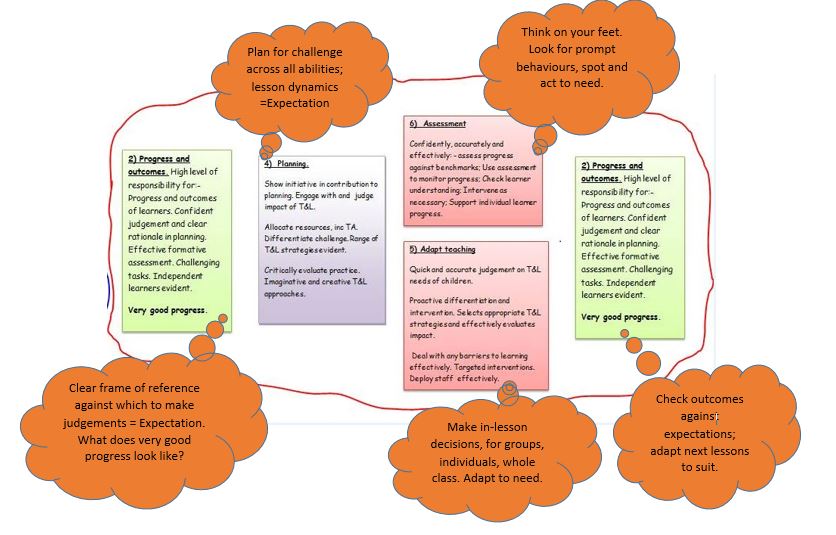During a long day in London, yesterday, where I was enjoying some sightseeing before meeting my daughter to see my grandson take part in a Chance to Dance, the Royal Opera House charity opportunity for children in some London boroughs to receive some high quality dance tuition and experience.
As it was hot, I took advantage of occasional shade and, inevitably, wandered into Twitter. A regular feature is assessment. It has been so for several years, and, surprise, no-one’s cracked the definitive approach.
I think everyone agrees that it has something to do with interacting with learners and their different parts of their learning journey, although that is sometimes differently expressed, occasionally with polarised views; you could occasionally sell the ice…
SATs and testing generally, are seen by some as an essential good, while others see them as blunt instruments of child torture that make an overall judgement based on narrow areas and, if Twitter is to be believed, subject to significant moderator error across a major subject component, writing.
In discussing assessment, the demise of previous use of levels is welcomed by many (on Twitter), with possibly equal numbers (not on Twitter) wishing they were still available, at least as a form of descriptor guidelines. It is certainly frustrating that, in the thirty years since levels appeared in the 1987 National Curriculum, that the descriptive aspects became lost in the data scramble that characterised the latter 1990s.
Levels, to some, are almost described anti-knowledge. As a practitioner when they were introduced, they were a useful addition to the knowledge areas, to describe the child’s ability to use and apply their knowledge in more challenging tasks, with a degree of independence.
Yesterday’s conversation was with Clare Sealy @ClareSealy, Tim Roach @MrTRoach, Kate Aspin @etaknipsa and Juliet Green @s0f0nisba, with occasional interjections from others, including Daisy Christodoulou @daisychristo. It would be impossible and impractical to utilise all the tweets. Suffice to say that there was a level of disagreement and an occasional meeting of minds; probably as there would be if we were face to face.
Some of the discussion also reflects the different roles and sectors of the participants, which inevitably adds a particular slant to points raised. Current classroom teachers spend a great deal of time interacting with learners and their outcomes, as has always been the case. There will be variation between Primary and Secondary due to frequency of contact and closeness of relationships; it’s easier to get to know 30 children with 25 hours a week contact than 200+ only seen a few times a week. Kate Aspin and I are both involved in ITE, so see the need of developing teachers, whose training involves at least two school placements, where each school may have radically different systems to guide interaction with learning.
Anyone reading my blog over the past few years, will know of my view that assessment is essentially what drives all teacher thinking, helping them with analysing the needs of the children in their class, planning effectively, delivering high quality lessons, with informed interactions, reflecting during and after the lesson, recording any necessary details to support their thinking. Assessment can be summarised as how well you know your children, from ongoing and summative activities.
A long conversation was generated by my tweet that proposed locality dialogue to agree standards, through guided moderation activity, which I think should be seen as staff development activity.
· 1987 reminisces. 85-87 National Writing Project improved process and outcomes. NC provided descriptors that enhanced collective dialogue.
· 1986 NC gave a language of notional progression that enhanced colleague dialogue. Previously was much less specific.
· The National Writing Project instituted the idea of dialogue between children and teachers, to establish quality and tentative next steps.
· Expectations rose, with greater clarity, so transition with l4 more than "good 3". Government exemplars also helped understanding.
· Local Advisors and inspectors worked to common agenda, so widespread sharing in local networks. Sharing outcomes included process discussion
· Strategies and APP distracted and distorted dialogue to minimalist progression; assuming learners would draw elements together. Skill loss.
· Holistic processes, well modelled, together with informed interaction and intervention is needed, then you have quality outcomes to judge
· Loss of common language reduces understanding and confidence in decisions; TS 2 drives 6&5, fine tuning to evident need.
· So teachers revert to activities, rather than developing learning journeys. APP style tracking makes this worse.
There were a number of organisational differences in 1987.
Class sizes were bigger, TAs didn’t exist and technology was very simple. Timetables, apart from PE and music (timetabled in the hall), were very much in the teacher’s hands, which meant that flexibility could be built into challenges, with writing tasks taking whole mornings, practical science investigations being developed over a week, or in the case of a need for an extra ten minutes to complete a task, children “bridging” playtimes and carrying on for a while, with transition to the next lesson delayed. “Quality First” meant quality outcomes ahead of time-limited activities, which can be more of a feature in a rigidly timetabled system. Activities are then designed to fit the available time; what can you really expect in the 20-30 minutes available?
Staff talking together and moderating outcomes began to use the common language, which enhanced their expectations and so outcome quality rose. Process enhancement from planning, through drafting, to evaluation of outcomes, led to further raising achievement.
Creating real audiences for outcomes, through open area displays and class books, created motivation and pride in presentation. So it became a case of create quality, share quality, unpick quality (enhance qualities of the writing), publish quality, so that children wanted to do more.
With the current situation with assessment being somewhat fluid, it can be very difficult for trainees and providers to give a clear overall picture of what they might encounter in schools. This year, School Direct trainees have encountered a different system in each of their placement schools, which adds to their performance concerns.
· Consider the need of developing teachers. Insecurity can lead to added workload, checking and double-checking. Mentoring essential.
· In a group of nine mentors, had seven different systems. New school experience, new system...
· Think the need to spend a bit of quality time talking together in locality could be seen as de facto CPD. Guided self-help groups?
I would like to see exemplar portfolios, locality and national, discussed with expert guidance, to share the thinking of an experienced colleague as they unpick the positive elements and learning needs being shown. This was a part of the original National Curriculum. Exemplar booklets, drawn from a wider area than our locality, showed what was being achieved elsewhere. This knowledge added to our local challenges.
Mentors need the confidence to be able to demonstrate what an acceptable standard of outcome is and what would be an aspirational outcome, so that the trainee had insights that supported learner journeys. In some ways, despite the availability of easy linking, through the internet, many schools are, like in 1987, little islands, which would be fine if they achieve highly, but could be disastrous for the children and their teachers if they do not have an idea of how high they could aspire; consider the needs of geographically disadvantaged schools.
The journey;
· the thinking processes in response to challenges; the development of a toolkit of ideas and words, within a knowledge rich environment; the ability and time to draft and alter ideas, forever seeking self-improvement through guidance and coaching dialogue; making the learner at least part-owner of their journey,
· takes time, reflection, high quality interaction and guidance, occasional detours for enhancement, but is always under the watchful eye of the teacher, who acts as overseer, quality control, guide and counsellor,
· building up progressive baselines of quality against which the next outcome can be compared.
In the “old days”, it was common practice, before levels, just to flick back in a child’s book to compare their current work with a previous piece. This was a simple mechanism to show them their own progress or that their output had declined.
From 1987, level descriptors and the National Writing Project approaches came together in a simple use of an exercise book, as many of you will have seen, but which might be of interest to new readers (see links below). It also gave rise to the use of one book for all writing, in whatever subject, to maintain a focus on the writing, for example, writing a science report, a trip account, how to play a sport, how a piece of art/DT was created, were all seen as report writing, so became the main focus for that week. Storyboarding and scaffolding aided first drafts, with interaction between drafts. Writing went across all subjects. Flip out sheets became prompts for in-lesson dialogue and evaluation. they were also a focus for detailed marking.
It wasn’t at all a bad approach. The outcomes in the last SATs of my headship gave us 90% level 4 and above writing scores. In a class of thirty, one child (3.3%) had come from Zimbabwe with limited English in year 6, but got a level 3a, with the other two achieving the same.
For children at that time, 2005, transition to Secondary was positive, as they enjoyed their learning and had some credit for their achievement, so did not have the stigma that can be attached to the current nomenclature “not at Age Related Expectation”. Implied failure, at any age, will be demotivating. On a long journey, you need encouragement to keep going, not a message to say that you’re not doing well enough.
Children need a language that allows them to clearly understand where they are in their journey, what they need to do next, and, more importantly, how they can achieve this; a stepped explanation and exemplification that is easy to access and use.
Teaching today can sometimes appear too full of jargon, to the detriment of learner progress. We need assessment language in child terms. If there’s a need to interpret this to data speak, that is a teacher level role.
After all, it’s all based on assessment; refined/agreed judgements, leading to quality challenge in tasks, not small scale busy work...
Remember 24652=refinement.
Draft-check-improve/redraft
National writing project; revival time?
All writing in one exercise book?
Writing process; tweak your books
Exercise books as personal organisers?
Selection of assessment blogs
Assessment WITH CHILDREN IN MIND
Assessment with Trainees and NQTs in mind
Assessing capability
Frames of Reference=FORmative assessment
Assessment=value Judgements





 RSS Feed
RSS Feed
